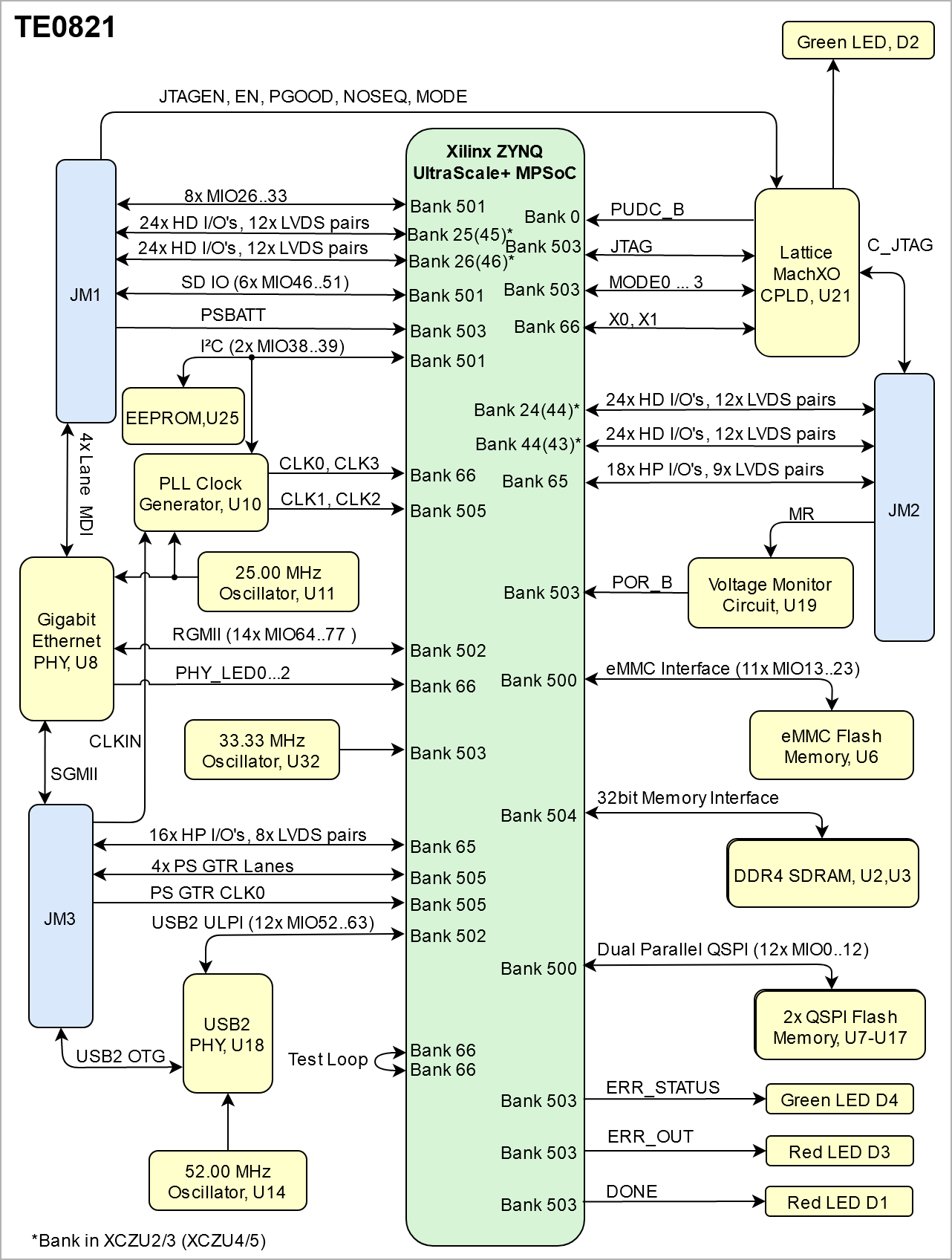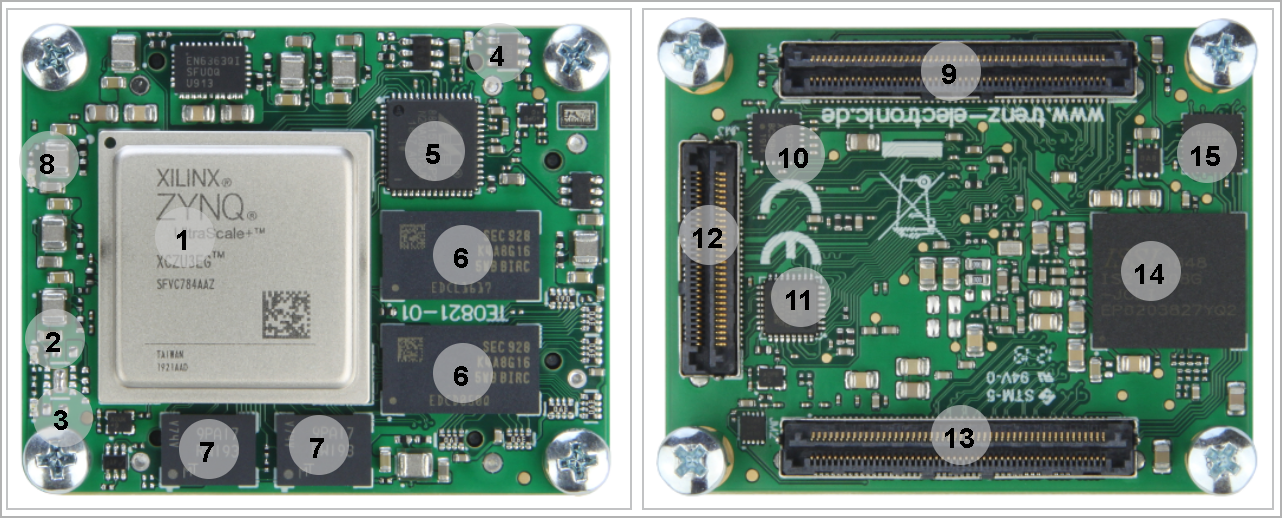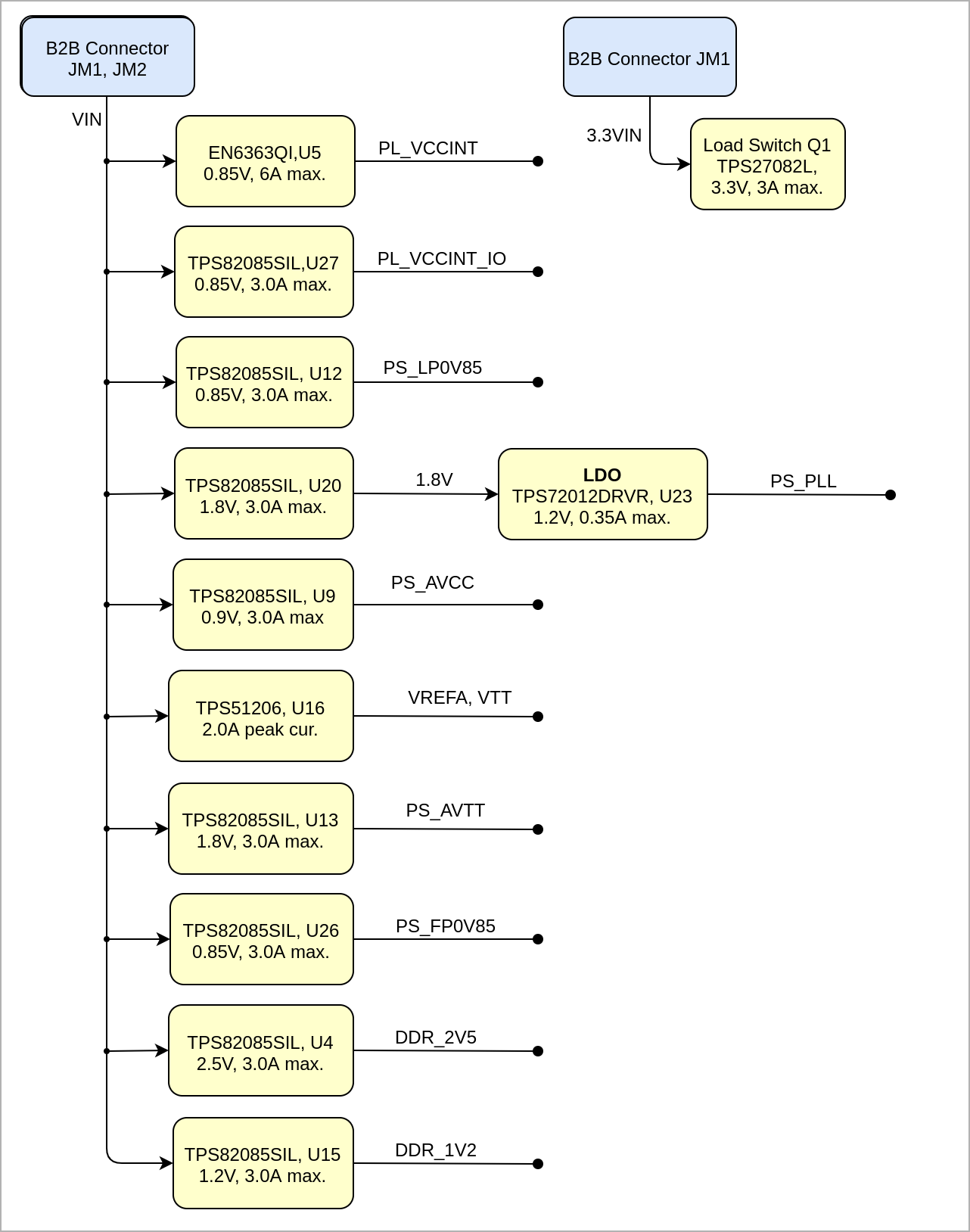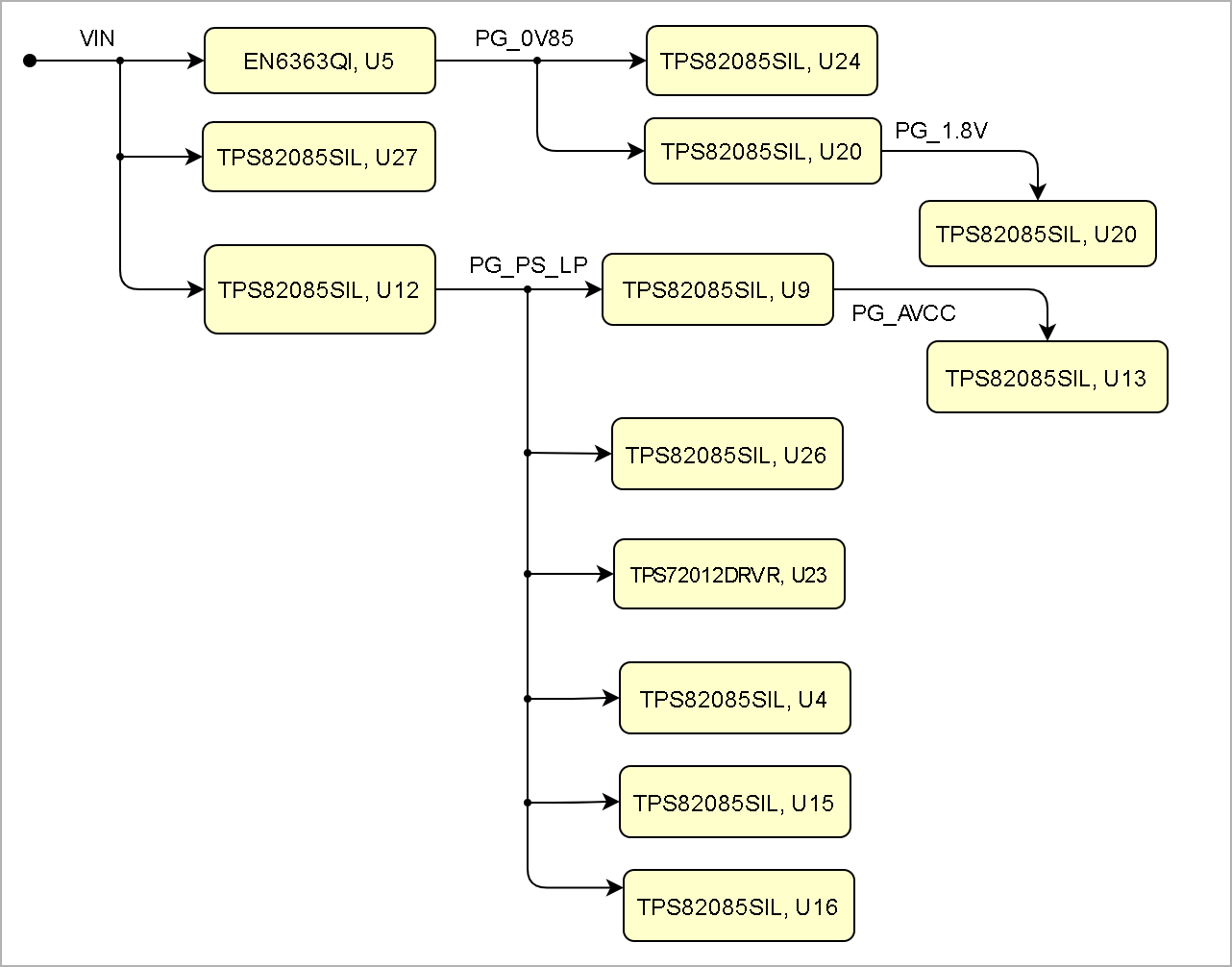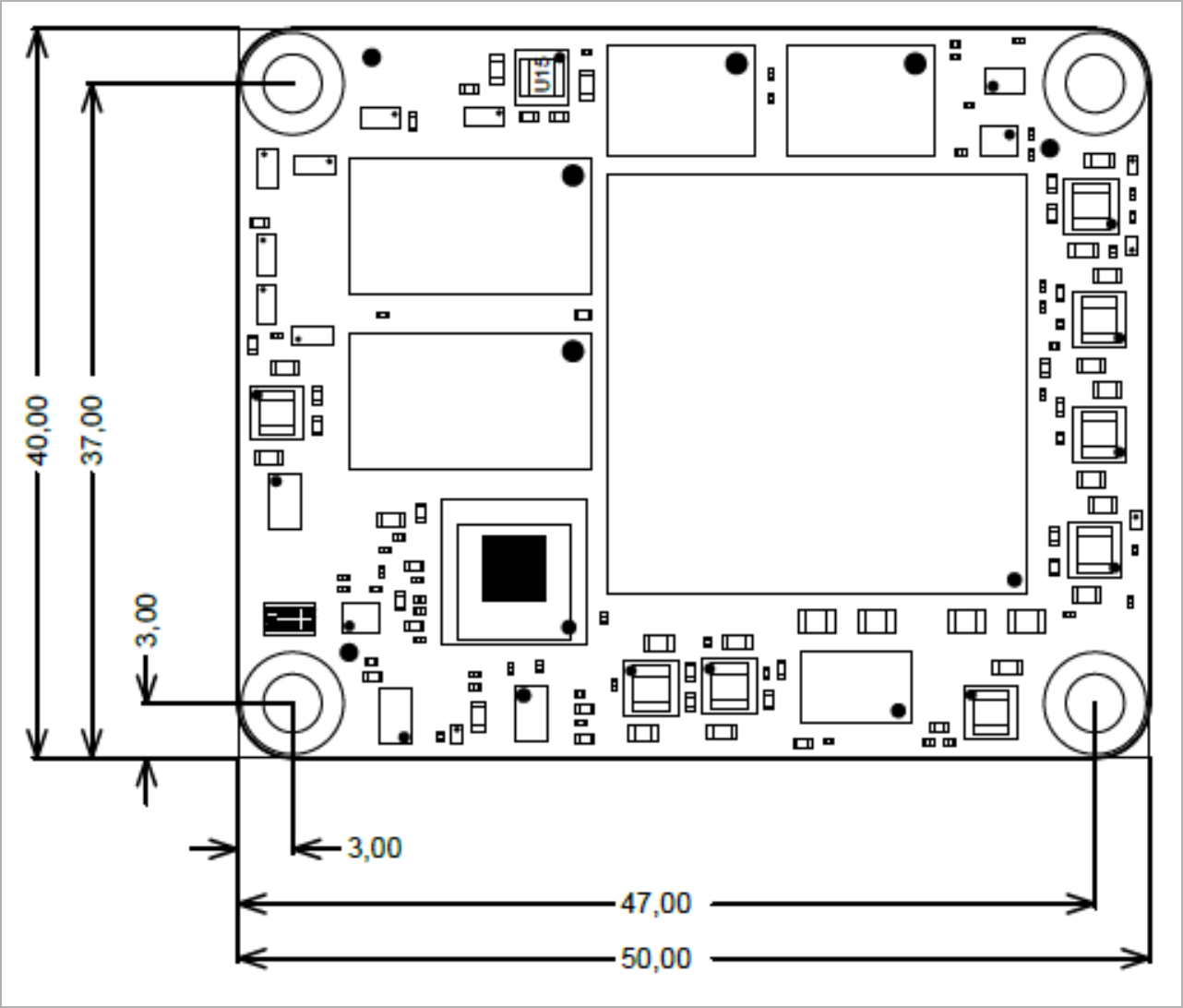Some sources are available: TE0821 Resources
Template Revision 2.12
- Module: TRM Name always "TE Series Name" +TRM
Example: "TE0728 TRM" - Carrier: TRM Name usually "TEB Series Name" +TRM
Example: "TEB0728 TRM"
|
<!-- tables have all same width (web max 1200px and pdf full page(640px), flexible width or fix width on menu for single column can be used as before) -->
<style>
.wrapped{
width: 100% !important;
max-width: 1200px !important;
}
</style> |
----------------------------------------------------------------------- |
Note for Download Link of the Scroll ignore macro: |
Table of Contents 
|
Overview
The Trenz Electronic TE0821-01-3BI21FA is a powerful 4 x 5 cm MPSoC module with a Xilinx Zynq UltraScale + ZU3EG. In addition, the module is equipped with a 2 GB DDR4 SDRAM chip, 128 MB flash memory for configuration and data storage, as well as powerful switching power supplies for all required voltages. Robust high-speed connectors provide a large number of inputs and outputs.
This module is pin compatible with Trenz Electronic TE0820 MPSoC modules (JM2 pin 100 is not connected).
The highly integrated modules are smaller than a credit card and are offered in several variants at an affordable price-performance ratio. Modules with a 4 x 5 cm form factor are completely mechanically and largely electrically compatible with each other.
All components cover at least the industrial temperature range from -40 ° C to + 85 ° C. The temperature range in which the module can be used depends on the customer design and the selected cooling. Please contact us for special solutions.
Refer to http://trenz.org/te0821-info for the current online version of this manual and other available documentation.
Key Features
Note:
'description: Important components and connector or other Features of the module
→ please sort and indicate assembly options Key Features' must be split into 6 main groups for modules and mainboards: - SoC/FPGA
- Package: SFVC784
- Device: ZU2...ZU5*
- Engine: CG, EG, EV*
- Speed: -1LI, -2LE,*, **
- Temperature: I, E,*, **
- RAM/Storage
- Low Power DDR4 on PS
- Data width: 32bit
- Size: def. 2GB*
- Speed:***
- eMMC
- Data width: 8Bit
- size: def. 8GB *
- QSPI boot Flash in dual parallel mode (size depends on assembly version)
- Data width: 8bit
- size: def. 128MB *
- HyperRAM/Flash (optional, default not assembled)
- MAC address serial EEPROM with EUI-48™ node identity (Microchip 24AA025E48)
- On Board
- Lattice LCMXO2
- PLL SI5338
- Gigabit Ethernet transceiver PHY (Marvell Alaska 88E1512)
- Hi-speed USB2 ULPI transceiver with full OTG support (Microchip USB3320C)
- Interface
- 132 x HP PL I/Os (3 banks)
- ETH
- USB
- 4 GTR (for USB3, Sata, PCIe, DP)
- MIO for UART
- MIO for SD
- MIO for PJTAG
- JTAG
- Ctrl
- Power
- 3.3V-5V Main Input
- 3.3V Controller Input
- Variable Bank IO Power Input
- Dimension
- Notes
- * depends on assembly version
- ** also non low power assembly options possible
- *** depends on used U+ Zynq and DDR4 combination
Key Features' must be split into 6 main groups for carrier: - Modules
- TE0808, TE807, TE0803,...
- RAM/Storage
- On Board
- Interface
- E.g. ETH, USB, B2B, Display port
- Power
- E.g. Input supply voltage
- Dimension
|
- SoC/FPGA
- Xilinx Zynq UltraScale+ XCZU3EG-1SFVC784I
- ZU3EG, 784 Pin Packages
- Application Processor: Quad-Core ARM Cortex-A53 MPCore
- Real-Time Processor: Dual-core ARM Cortex-R5 MPCore
- Graphics Processor: Mali-400 MP2
- RAM/Storage
- 2 GByte DDR4 SDRAM, 32-Bit databus-width
- 128 MByte QSPI boot Flash in dual parallel mode
- 8 GByte e.MMC Memory (up to 64 GByte)
- MAC address serial EEPROM with EUI-48 node identity
- On Board
- Graphic Processing Unit (GPU) :Mali-400 MP2
- Interface
- Power
- All power supplies on board
- Dimension
Block Diagram
Main Components
Notes : - Picture of the PCB (top and bottom side) with labels of important components
- Add List below
|
- Xilinx Zynq UltraScale+ XCZU3EG, U1
- Red LED (ERR_OUT), D3
- Green LED (ERR_STATUS), D4
- Red LED (DONE), D1
- GigaBit Ethernet Transceiver, U8
- 8Gb DDR4, U2-U3
- 512 Mb SPI Flash, U7-U17
- Board to Board Connector, JM1
- USB2.0 Transceiver, U18
- Board to Board Connector, JM3
- Board to Board Connector, JM2
- eMMC, U17
Initial Delivery State
Notes : Only components like EEPROM, QSPI flash can be initialized by default at manufacture. If there is no components which might have initial data ( possible on carrier) you must keep the table empty |

Storage device name | Content | Notes |
|---|
SPI Flash OTP Area | Not programmed | Except serial number programmed by flash vendor. | SPI Flash Quad Enable bit | Programmed | - | SPI Flash main array | Not programmed | - | eFUSE USER | Not programmed | - | eFUSE Security | Not programmed | - | | Si5338 OTP NVM | Not programmed | - | | CPLD (LCMXO2-256HC) | SC0820-02 QSPI Firmware | See Boot Process section. |
|
Configuration Signals
- Overview of Boot Mode, Reset, Enables.
|
Two different firmware versions are available, one with the QSPI boot option and other with the SD Card boot option.

MODE Pin | Boot Mode |
|---|
| Low | QSPI | | High | SD Card |
|
Signals, Interfaces and Pins
Notes : - For carrier or stand-alone boards use subsection for every connector type (add designator on description, not on the subsection title), for example:
- For modules which needs carrier use only classes and refer to B2B connector if more than one is used, for example
|
Board to Board (B2B) I/Os
FPGA bank number and number of I/O signals connected to the B2B connector:

| FPGA Bank | B2B Connector | I/O Signal Count | I/O Signal Count | Voltage Level | Notes |
|---|
64 | HP | JM2 | 48 | User | Max voltage 1.8V | 64 | HP | JM2 | 2 | User | Max voltage 1.8V | | 65 | HP | JM2 | 18 | User | Max voltage 1.8V | 65 | HP | JM3 | 16 | User | Max voltage 1.8V | 66 | HP | JM1 | 48 | User | Max voltage 1.8V | | 500 | MIO | JM1 | 8 | 1.8V | - | 501 | MIO | JM1 | 6 | 3.3V | - | 505 | GTR | JM3 | 4 lanes | - | - | 505 | GTR CLK | JM3 | 1 differential input | - | - |
|
JTAG Interface
JTAG access to the TExxxx SoM through B2B connector JMX.

JTAG Signal | B2B Connector |
|---|
| TMS | JM2-93 | | TDI | JM2-95 | | TDO | JM2-97 | | TCK | JM2-99 |
|
Pin 89 JTAGEN of B2B connector JM1 is used to control which device is accessible via JTAG. If set to low or grounded, JTAG interface will be routed to the Xilinx Zynq MPSoC. If pulled high, JTAG interface will be routed to the System Controller CPLD.
MIO Pins
you must fill the table below with group of MIOs which are connected to a specific components or peripherals, you do not have to specify pins in B2B, Just mention which B2B is connected to MIOs. The rest is clear in the Schematic. Example: | MIO Pin | Connected to | B2B | Notes |
|---|
| MIO12...14 | SPI_CS , SPI_DQ0... SPI_DQ3 SPI_SCK | J2 | QSPI |
|

| MIO Pin | Connected to | B2B | Notes |
|---|
|
|
|
|
|
|
|
|
|
|
|
|
|
|
|
|
|
|
|
|
|
|
|
|
|
|
|
|
|
|
|
|
|
|
|
|
|
Test Points
you must fill the table below with group of Test Point which are indicated as TP in a schematic. If there is no Test Point remarked in the schematic, delet the Test Point section. Example: | Test Point | Signal | B2B | Notes |
|---|
| 10 | PWR_PL_OK | J2-120 |
|
|

| Test Point | Signal | Connected to | Notes |
|---|
|
|
|
|
|
|
|
|
|
|
|
|
|
|
|
|
|
|
|
|
|
|
|
|
|
|
|
|
|
|
|
|
|
|
|
|
|
On-board Peripherals
Notes : - add subsection for every component which is important for design, for example:
- Two 100 Mbit Ethernet Transciever PHY
- USB PHY
- Programmable Clock Generator
- Oscillators
- eMMCs
- RTC
- FTDI
- ...
- DIP-Switches
- Buttons
- LEDs
|
Notes : In the on-board peripheral table "chip/Interface" must be linked to the corresponding chapter or subsection |

| Chip/Interface | Designator | Notes |
|---|
|
|
|
|
|
|
|
|
|
|
|
|
|
|
|
|
Quad SPI Flash Memory
Notes : Minimum and Maximum density of quad SPI flash must be mentioned for other assembly options. |

| MIO Pin | Schematic | U?? Pin | Notes |
|---|
|
|
|
|
|
|
|
|
|
|
|
|
|
|
|
|
|
|
|
|
|
|
|
|
|
EEPROM

| MIO Pin | Schematic | U25 Pin | Notes |
|---|
| MIO39 | I2C_SDA | SDA |
| | MIO38 | I2C_SCL | SCL |
|
|

| MIO Pin | I2C Address | Designator | Notes |
|---|
| MIO38...39 | 0x50 | U25 |
|
|
LEDs

| Designator | Color | Connected to | Active Level | Note |
|---|
| D1 | Red | DONE | High |
| | D2 | Green | ERR_STATUS | High |
| | D3 | Red | ERR_OUT | High |
|
|
DDR3 SDRAM
Notes : Minimum and Maximum density of DDR3 SDRAM must be mentioned for other assembly options. (pay attention to supported address length for DDR3) |
The TE0821 SoM has 8 Gb volatile DDR4 SDRAM IC for storing user application code and data.
- Part number: K4A8G165WB-BIRC
- Supply voltage: 1.2V
- Speed: 2400 mbps
- Temperature: -40 ~ 95 °C
Ethernet

| U?? Pin | Signal Name | Connected to | Signal Description | Note |
|---|
|
|
|
|
|
|
|
|
|
|
|
|
|
|
|
|
|
|
|
|
|
|
|
|
|
|
|
|
|
|
|
|
|
|
|
|
|
|
|
|
|
|
|
|
|
|
|
|
|
|
|
|
|
|
|
|
|
|
|
|
|
|
|
|
|
|
|
|
|
|
|
Clock Sources

| Designator | Description | Frequency | Note |
|---|
| U11 | MEMS Oscillator | 25 MHz |
| | U14 | MEMS Oscillator | 25 MHz |
|
|
Programmable Clock Generator
There is a programmable clock generator on-board (U??) provided in order to generate variable clocks for the module. Programming can be done using I2C via PIN header J??. The I2C Address is 0x??.

U?? Pin
| Signal | Connected to | Direction | Note |
|---|
IN0 |
|
|
|
| | IN1 |
|
|
|
| | IN2 |
|
|
|
| | IN3 |
|
|
|
| XAXB |
|
|
|
| | SCLK |
|
|
|
| | SDA |
|
|
|
| | OUT0 |
|
|
|
| | OUT1 |
|
|
|
| | OUT2 |
|
|
|
| | OUT3 |
|
|
|
| | OUT4 |
|
|
|
| | OUT5 |
|
|
|
| | OUT6 |
|
|
|
| | OUT7 |
|
|
|
| | OUT8/OUT9 |
|
|
|
|
|
Power and Power-On Sequence
In 'Power and Power-on Sequence' section there are three important digrams which must be drawn: - Power on-sequence
- Power distribution
- Voltage monitoring circuit
|
Power Supply
Power supply with minimum current capability of xx A for system startup is recommended.
Power Consumption

| Power Input Pin | Typical Current |
|---|
| VIN | TBD* |
|
* TBD - To Be Determined
Power Distribution Dependencies
Power-On Sequence
Voltage Monitor Circuit
Create DrawIO object here: Attention if you copy from other page, objects are only linked. |
image link to the generate DrawIO PNG file of this page. This is a workaround until scroll pdf export bug is fixed |
|
Power Rails

| Power Rail Name | B2B Connector JM1 Pin | B2B Connector JM2 Pin | B2B Connector JM3 Pin | Direction | Notes |
|---|
|
|
|
|
|
|
|
|
|
|
|
|
|
|
|
|
|
|
|
|
|
|
|
|
|
Bank Voltages
Board to Board Connectors
- This section is optional and only for modules.
use "include page" macro and link to the general B2B connector page of the module series, For example: 6 x 6 SoM LSHM B2B Connectors

|

Technical Specifications
Absolute Maximum Ratings

| Symbols | Description | Min | Max | Unit |
|---|
|
|
|
| V |
|
|
|
| V |
|
|
|
|
|
|
|
|
|
|
|
Recommended Operating Conditions
Operating temperature range depends also on customer design and cooling solution. Please contact us for options.

| Parameter | Min | Max | Units | Reference Document |
|---|
|
|
| V | See ???? datasheets. |
|
|
| V | See Xilinx ???? datasheet. |
|
|
| °C | See Xilinx ???? datasheet. |
|
|
| °C | See Xilinx ???? datasheet. |
|
Physical Dimensions
PCB thickness: 1.74 mm.
Currently Offered Variants
Revision History
Hardware Revision History

| Date | Revision | Changes | Documentation Link |
|---|
| 2019-04-26 | REV01 | | REV01 |
|
Hardware revision number can be found on the PCB board together with the module model number separated by the dash.
Document Change History
- Note this list must be only updated, if the document is online on public doc!
- It's semi automatically, so do following
Add new row below first Copy "Page Information Macro(date)" Macro-Preview, Metadata Version number, Author Name and description to the empty row. Important Revision number must be the same as the Wiki document revision number Update Metadata = "Page Information Macro (current-version)" Preview+1 and add Author and change description. --> this point is will be deleted on newer pdf export template - Metadata is only used of compatibility of older exports
|

| Date | Revision | Contributor | Description |
|---|
| | 
| | -- | all | 
| |
|
Disclaimer


